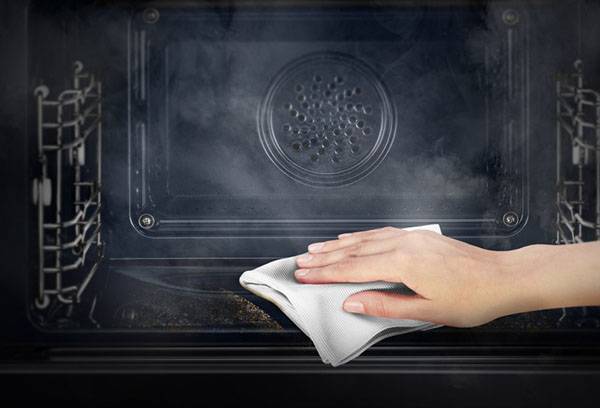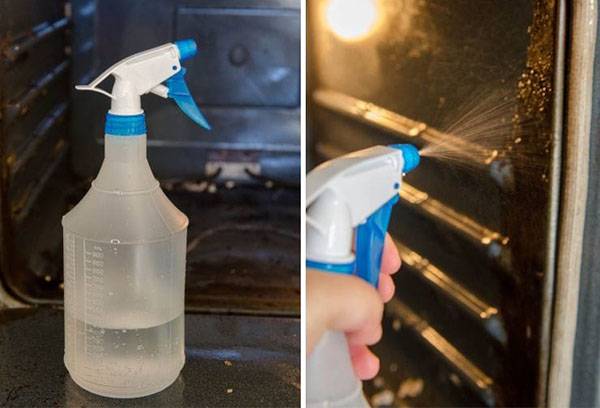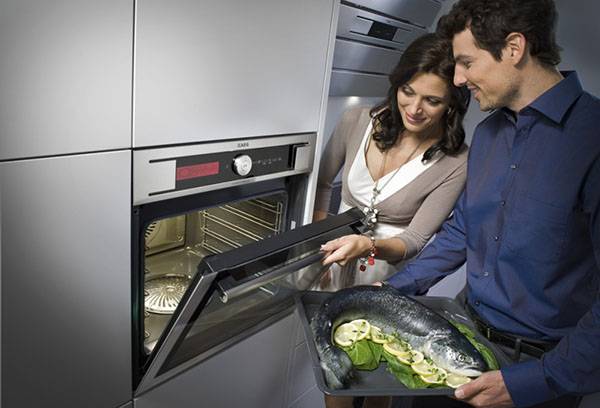Features of cleaning the oven with steam
Content:
Perhaps cleaning the oven at home from grease and other contaminants is a rather unpleasant procedure. Fat adheres to internal surfaces during cooking, so those who like to cook often, alas, cannot avoid this problem. In order for the device to last longer, while maintaining an ideal appearance, it is necessary to periodically remove this fat.
Steam cleaning, or hydrolysis cleaning, is a simple way by which you can remove grease from the inside of the oven without resorting to aggressive household chemicals. But you need to know that the method does not guarantee complete cleansing of fat. Strong pollution can still remain. Steam cleaning only facilitates subsequent washing.
What is hydrolysis cleaning? Hydro says that this method uses water. Indeed, in order to clean the household appliance in this way, water is poured into the pan with the addition of a small amount of cleaning agent. After that, the device door is closed and the temperature is set at a level of 90-190 degrees Celsius. Water begins to turn into steam, affecting body fat. It is recommended to use steam when the dirt in the oven is not yet dry.
Tip
A cleaning agent added to the water will help to more easily remove grease from the walls.
Ovens with integrated steam cleaning function
In some ovens, for example from Samsung, there is a special function called “Steam Cleaning”. What it is? Using it, dirt is removed in a similar way.
- First, all kitchen utensils contained in it are removed from the household appliance.
- Then about 400 ml of water is poured into the bottom of the oven. After this, the door must be tightly closed.
- The function "Steam cleaning" is activated.
- The device will notify the owner with a sound signal about the end of cleaning. After it sounds, you can set the shutdown mode to complete the process.
- Upon completion of all manipulations, the internal surfaces of the oven are wiped with a cloth. If water remains at the bottom, then it can be removed using a porous sponge.
- You can leave the door ajar at 15 °, so that the enamel is completely dry.
Owners of ovens with the “Steam Cleaning” function should also know some rules.
- After opening the door of the appliance, care must be taken: the water remaining at the bottom of the oven is very hot.
- If the oven is very dirty, the steam cleaning procedure can be repeated many times.
- It is not recommended to leave water in the oven overnight.
- In case of severe contamination, a cleaning agent can be added to the water.
Household appliances with hydrolysis have some features. So, getting rid of dirt with the help of steam is not recommended to be practiced regularly. Hydrolysis combined with cleaning products can contribute to corrosion of the inside of the oven. However, a number of manufacturers of such devices use enamel when creating their home appliances, which can withstand the effects of alkalis and acids.
Some models of such devices have special electronic programs that regulate the time of steam exposure. In some household appliances, the manufacturer recommends using a special cleaning composition instead of water for hydrolysis. As in the case of water, they also need to fill the tank and turn on the oven. Models with the Cleaning system require the use of special sprays.They replace the action of steam. Models of household appliances with the Aqua Clean system for hydrolysis cleaning require only 1/2 liter of plain water and 50 degrees Celsius. In just half an hour, the inner surface of such ovens gets rid of pollution.
Curious fact: in the same way you can clean the inside of the microwave oven. It is enough to pour water into a bowl and heat it for several minutes.
In some models of ovens where hydrolysis is provided, water is not poured into a baking sheet, but into a circular recess provided specifically for this purpose.
What else can be solutions for cleaning the oven
The easiest method to clean the oven is to purchase household chemicals specifically designed for this purpose. Detergents for ovens can be purchased at stores in household cleaning departments. The cost of such reagents is usually low, and one bottle lasts for a long time. When cleaning using a similar method, you need to know that any contamination is better removed if it is pre-moistened with water. The disadvantage of using such products is their overly aggressive effect on the inside of the oven. In some cases, enamel can be damaged from household chemicals.
Some kitchen ovens use special self-cleaning enamel. Fatty deposits practically do not stick to such a coating. And if something burns, then dirt can easily be removed with a damp cloth without the use of household chemicals. Typically, pores of such enamel contain particles of catalyst. This contributes to the process of decomposition of fats. This cleaning method is called catalytic. A similar method is considered low-temperature, because it occurs when the oven is heated to 140-200 degrees Celsius. To increase the efficiency of such a method, manufacturers propose to install an additional filter that absorbs fat in devices with such a cleaning system.
Another way to clean a household appliance is pyrolysis. With pyrolytic cleaning, all food debris and fat are burned cleanly. But this is also the most severe way to clean. After its use, only ash remains in the oven chamber. During pyrolysis inside the oven, food and fat burn out at high temperatures. At the same time, in the process, the oven door is locked, so it is impossible to even open it on your own. At high temperatures, the household appliance experiences enormous loads. Such devices are offered by manufacturers Bosch, Gaggenau and others. They provide a level pyrolysis system. Some contaminants, such as food particles, can be burned at 200-300 degrees Celsius, so a level system was developed. It saves energy during the cleaning process.
Which oven cleaning is better - catalytic, pyrolytic or steam?
Each cleaning method has its advantages and disadvantages. Let's consider them separately.
Catalytic purification is found in both gas and electric ovens. With this method, fat is removed during cooking, so no additional costs for electric energy are needed. Such a cleaning method requires virtually no human supervision. But the catalytic panels eventually become unusable and have to be changed. In addition, ovens with them are not so cheap. Self-cleaning enamel does not cover all surfaces of the oven, so individual elements still have to be washed by hand.
Hydrolysis treatment occurs at low temperatures. To implement it, you do not need large cash outlay. This method does not require much power consumption. The most significant drawback of this method is that it does not eliminate all contaminants. The type of cleaning hydrolysis is, rather, an auxiliary method before washing the oven.However, if the particles of food and fat on the inner walls of the oven are not dried, but are in a softened state, then such cleaning will be quite effective.
With pyrolytic cleaning, the oven does not require "analysis" into its components. Eliminates the need to remove the pan. The type of pyrolysis treatment is the most effective method of getting rid of pollution. In the ovens where it is provided, special high-quality materials are used that can withstand high temperatures. However, pyrolysis ovens are more expensive than the others; moreover, an unpleasant burning odor can occur during pyrolysis. Also, in some built-in ovens, the side walls can become very hot during this process.
Each cleaning method has its pros and cons. However, steam cleaning the oven is the most affordable way and the least expensive. You can implement it in almost any oven. In general, steam cleaning makes it easier to take care of your home appliance. It can be carried out even without additional cleaning agents.


